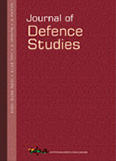Naval Operations Analysis in the Indian Ocean Region A Review
The end of the Cold War resulted in a fundamental swing from a navy designed to engage a blue water battle fleet to one focused on forward operations in littoral waters. The Cold War era had fuelled massive research and development (R&D) in design of sonars that was able to substantially minimize the uncertainties of the underwater environment. The shift of the naval theatre to the littoral waters led to a paradigm change in terms of technology requirements to retain the effectiveness of these sonars.
- Arnab Das |
- January 2013 |
- Journal of Defence Studies




